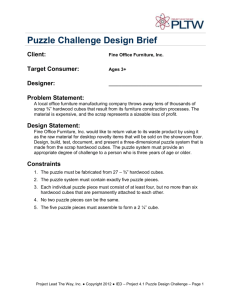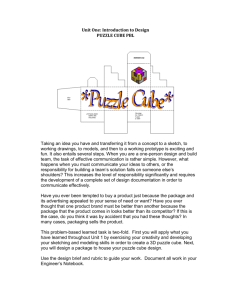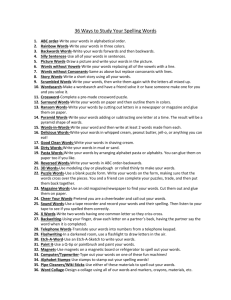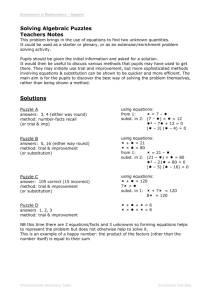Project 4.1 Puzzle Design Challenge Introduction
advertisement
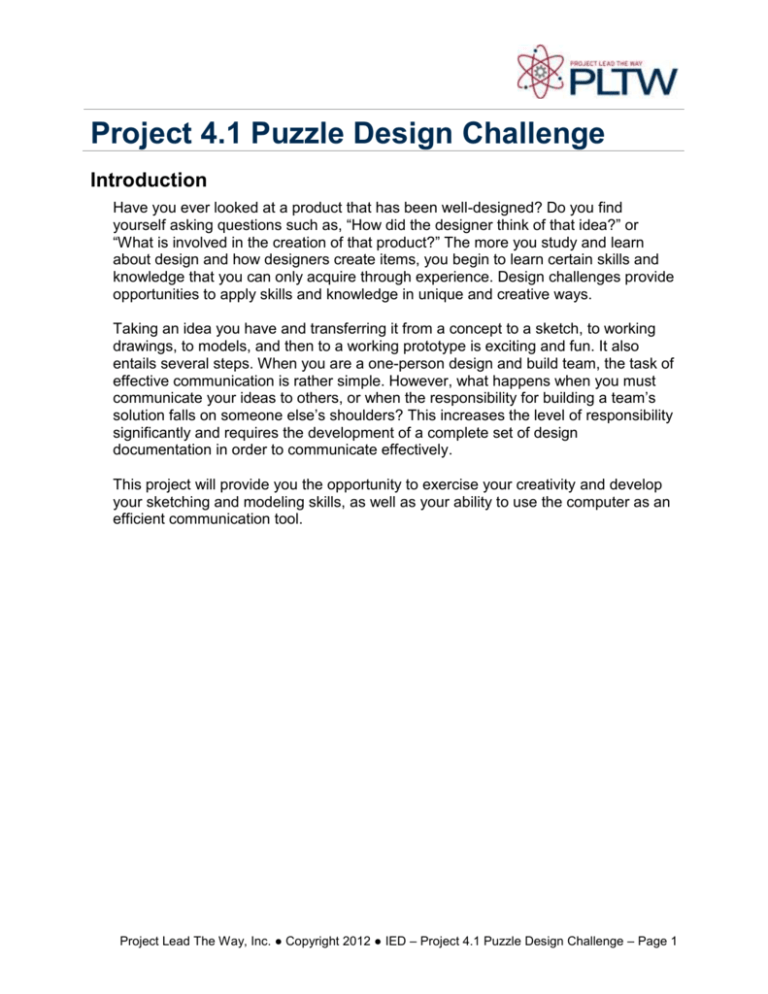
Project 4.1 Puzzle Design Challenge Introduction Have you ever looked at a product that has been well-designed? Do you find yourself asking questions such as, “How did the designer think of that idea?” or “What is involved in the creation of that product?” The more you study and learn about design and how designers create items, you begin to learn certain skills and knowledge that you can only acquire through experience. Design challenges provide opportunities to apply skills and knowledge in unique and creative ways. Taking an idea you have and transferring it from a concept to a sketch, to working drawings, to models, and then to a working prototype is exciting and fun. It also entails several steps. When you are a one-person design and build team, the task of effective communication is rather simple. However, what happens when you must communicate your ideas to others, or when the responsibility for building a team’s solution falls on someone else’s shoulders? This increases the level of responsibility significantly and requires the development of a complete set of design documentation in order to communicate effectively. This project will provide you the opportunity to exercise your creativity and develop your sketching and modeling skills, as well as your ability to use the computer as an efficient communication tool. Project Lead The Way, Inc. ● Copyright 2012 ● IED – Project 4.1 Puzzle Design Challenge – Page 1 Puzzle Challenge Design Brief Client: Fine Office Furniture, Inc. Target Consumer: Ages 3+ Designer: _____________________________________ Problem Statement: A local office furniture manufacturing company throws away tens of thousands of scrap ¾” hardwood cubes that result from its furniture construction processes. The material is expensive, and the scrap represents a sizeable loss of profit. Design Statement: Fine Office Furniture, Inc. would like to return value to its waste product by using it as the raw material for desktop novelty items that will be sold on the showroom floor. Design, build, test, document, and present a three-dimensional puzzle system that is made from the scrap hardwood cubes. The puzzle system must provide an appropriate degree of challenge to a person who is three years of age or older. Constraints 1. The puzzle must be fabricated from 27 – ¾” hardwood cubes. 2. The puzzle system must contain exactly five puzzle pieces. 3. Each individual puzzle piece must consist of at least four, but no more than six hardwood cubes that are permanently attached to each other. 4. No two puzzle pieces can be the same. 5. The five puzzle pieces must assemble to form a 2 ¼” cube. Project Lead The Way, Inc. ● Copyright 2012 ● IED – Project 4.1 Puzzle Design Challenge – Page 2 Project 4.1 Puzzle Design Challenge IED Mid-Term Test Grade Due Date: __________________________ Final Deliverables: Create a project portfolio to include the following: o Title page Project title Image of your design from Inventor Your Name/AMB Project due date o Design Brief from Ms Hamby, your name as designer o Isometric sketches of two possible complete Puzzle Cube designs. These can be completed on isometric graph paper or regular graph paper. Neat and colored pencil shaded, portrait page orientation o Decision Matrix produced using Excel, portrait page orientation o CAD drawings. Holes punched at the top of the images. Title block correctly filled out, all caps,AMB Assembled isometric Exploded isometric with balloons and parts list 5 fully dimensioned multi-view drawings (one of each puzzle piece) o Written assembly directions with images from Inventor for each step. o Project rubric o ****You will also create a physical model of your puzzle. And demonstrate it during our Puzzle Cube Party during Mid-term week Note: Grades will be taken along the way for project milestones, including evidence of brainstorming, quality assessment, decision matrix, puzzle solution demonstration. Project Lead The Way, Inc. ● Copyright 2012 ● IED – Project 4.1 Puzzle Design Challenge – Page 3 Conclusion 1. Why is it important to model an idea before making a final prototype? 2. Which assembly constraint(s) did you use to constrain each piece of the puzzle to the assembly such that it did not move? Describe each constraint used and explain the degrees of freedom that are removed when each is applied between two parts. You may wish to create a sketch to help explain your description. Project Lead The Way, Inc. ● Copyright 2012 ● IED – Project 4.1 Puzzle Design Challenge – Page 4

